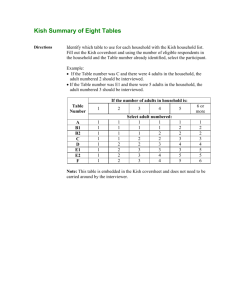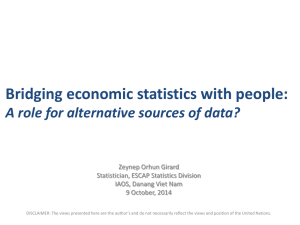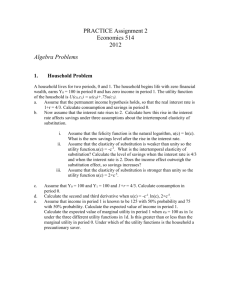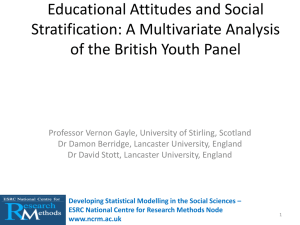Are you a Rotten Kid?
advertisement
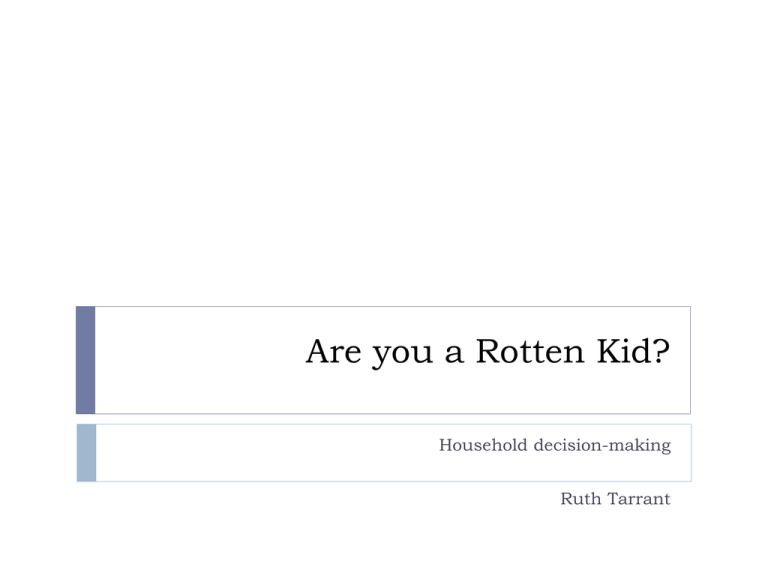
Are you a Rotten Kid? Household decision-making Ruth Tarrant “The family is a remarkable institution. And a complex one. Indeed, so complex that much of economic theory proceeds as if no such thing exists” Sen, A. (1984) Resources,Values and Developments, Cambridge: MA, Harvard University Press Why live in a multi-person household? Economies of scale in z-goods Gains from comparative advantage Implicit loans A husband may continue to work and fund his wife through a course, for example Savings Different household members are better at different activities One partner may work and build up savings that can be used by the other Risk-pooling It’s unlikely that both partners will lose a job simultaneously UK population statistics (1) UK population statistics (2) UK population statistics (3) The household as a black box Yes! Paul Samuelson Gary Becker “Blood is thicker than water” – cohesion and mutual altruism Maximise the utility of the altruistic household head Samuelson, P (1956) ‘Social Indifference Curves’ The Quarterly Journal of Economics, 70(1) pp.1-22 Becker, G.S. (1974) ‘A theory of social interactions’, Journal of Political Economy 82(6) pp.1063-1093 Who is the household head? Your family Who has the greatest decision-making power? Who earns the most? Are the two linked? What other factors affect the balance of decision-making power in your household? Who is the household head? Becker: main ‘breadwinner’ Whoever earns more has control over their own money and that of their spouse Not so! 2005-06 Indian National Family Health Survey 80% households: male breadwinner 10% households : female breadwinner 10% households: male and female equal breadwinners Decision-making: 2.2% women controlled resources 24% women had sole control over their earnings “parents are concerned not merely with their children’s utilities, but with their children’s consumption patterns (e.g. parents may be willing to pay for college tuition or a down payment on a house, but not a Mercedes or a trip around the world)” Non-unitary decision-making models Models that allow for individual members of a household with different preferences influencing household decisions Non-cooperative Cooperative Separate Spheres Bargaining models Separate Spheres model - assumptions Couple behaving according to ‘traditional’ gender roles Man contributes money from paid work Woman contributes time to the household Both get utility from z-goods They have to decide how much money/time to contribute to producing z-goods, either L (low) or H (high) One-shot game Separate Spheres model - outcome Cooperative models Cooperative models Collective model: maximise a household utility function, which is a combination of all household members’ utility functions Cooperative model What factors do you think affect the position of the threat point, T? Utility possibility frontier showing self-regarding preferences T shows the maximum utility each can achieve on their own Shaded area shows outcomes that are preferred to T by at least 1 partner Caring preferences (1) Caring preferences (2) Which model gets your vote? Gary Becker (Rotten Kid) Paul Samuelson (Black Box) Everyone in the household agrees how to allocate resources Separate Spheres One altruistic household head allocates resources Specialise according to comparative advantage but do as little as possible Bargaining model (co-operative model) Resource allocation depends on relative bargaining power of household members



